Rolex Daytona vs. Submariner Review
Rolex Submariner vs. Rolex Daytona
When choosing a watch to accompany you on an adventure, it is important to select one that offers the appropriate features. For those interested in activities from racing to diving, Rolex offers watches designed with those specific activities in mind. Two of the most impressive models are the Daytona and the Submariner. But which is the best to invest in? For that answer, it is important to examine the many features of both, then compare them to what you wish to use the watch for.
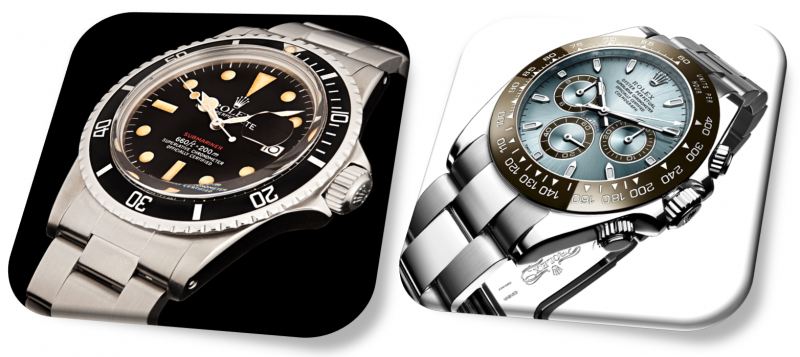
In a head-to-head competition, which model wins: the Rolex Submariner or the Rolex Daytona? The fact is that both watches have definite advantages and are suitable for different purposes. While the Submariner is a bit more casual than the Daytona, both blend well with a variety of dress styles.
If you are on the fence and don't know which model is best for your current needs read on. Bob's Watches will give you a side by side comparison pointing out the good and bad for both models.
Submariner |
Daytona |
|
$5,000 - $15,000 |
Pricing |
$6,500 - $25,000 |
1953 |
First Year Manufactured |
1963 |
Self-Winding |
Chronometer |
Self-Winding |
330 Feet (100 Meters) |
Pressure Proof Depth |
330 Feet (100 Meters) |
Yes |
Date Feature |
No |
No |
Chronograph Feature |
Yes |
Link/Material |
Band Type |
Link/Material |
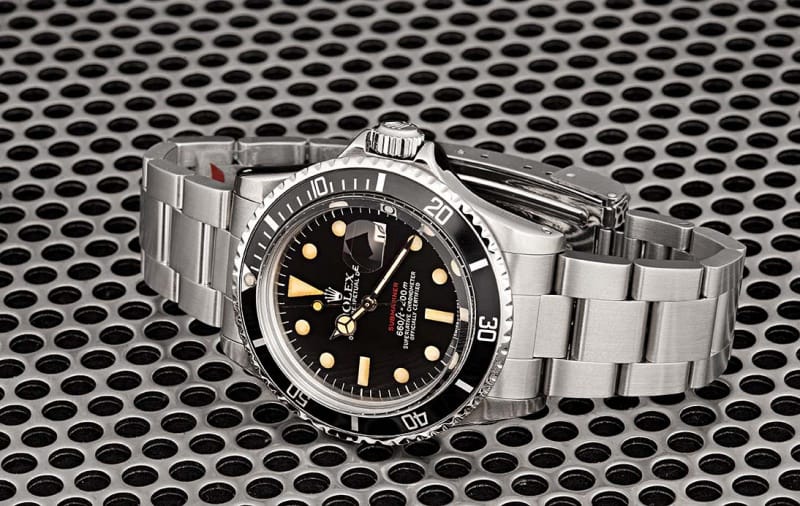
The Rolex Submariner Story
Since man first laid eyes on the ocean, they have sought out its many mysteries. For those who dare to explore its depths, Rolex offers the Submariner, first created in the pioneering era of scuba diving, designed specifically for divers.
The history of the Rolex Submariner began in 1954 after the company was urged to create a practical and beautiful dive watch. With attention to the details that keep divers safe, such as a unidirectional turning bezel and easy-to-read numbers, Rolex introduced the Submariner as a "working" watch. However, it shot to popularity when it was worn by both Sean Connery and Roger Moore as James Bond as well as the legendary Steve McQueen.
The Submariner - A Diver's Watch
The Submariner is the archetype of the diver’s watch. It, like the Daytona with speed, truly links the wearer and the underwater world. Designed specifically for underwater exploration and diving, it featured many revolution elements, including a waterproof oyster case.
Mimicking an oyster shell, the Oyster case offers a screw-down back and bezel and a screw-down waterproof winding crown, preventing water from permeating its interior. This technology was originally invented by Rolex in 1926. Shortly thereafter, it was tested true by Mercedes Gleitze who swam the English Channel wearing a Rolex Oyster. It was free of water upon her arrival on the other side. The current Submariner’s Oyster case is guaranteed to remain waterproof to a depth of 300 meters (1,000 feet). It also protects from dust, pressure, and shocks, ensuring the watch continues to work precisely.
Accompanying the Oyster case, the Oyster stainless steel bracelet is both strong and comfortable. Its Oysterlock clasp prevents accidental opening. The Oyster bracelet also allows fine adjustments without the use of tools. Thus, it can be quickly altered to be worn over a diving suit.
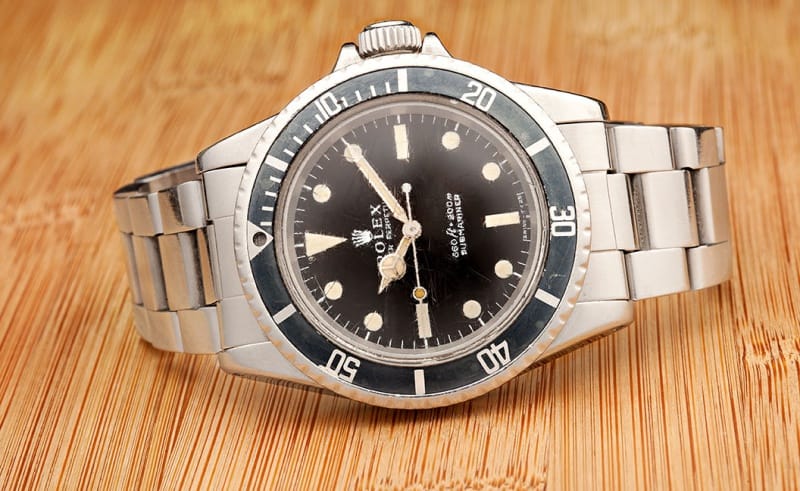
Diving Features
Other features of the Submariner Oyster were created specifically with divers in mind. For example, the Submariner's rotatable bezel is engraved with 60-minute graduations. These convenient measure marks allow a diver to accurately and safely monitor diving time and decompression stops. The bezel is also virtually scratch proof, created from the hard, corrosion-resistant ceramic Cerachrom. The Cerachrom bezels also maintain their vibrant colors over time, and are unaffected by exposure to sunlight. The Cerachrom bezels are also resistant to corrosion from both chlorinated and sea water, making it usable in any water activity. The Triplock winding crown was also designed by Rolex especially for diver watches, resisting water pressure to depths of 300 meters (1,000 feet) to 3900 meters (12,800 feet), depending on the model.
Diving can lead the user into dark or low visibility areas. The Chromalight display on the dial glows blue, which lasts up to eight hours. It maintains a uniform luminosity throughout, ensuring the entire piece is visible.
Inside, the Submariner is equipped with calibre 3130. This self-winding mechanical movement was entirely developed and manufactured by Rolex, and is certified by Swiss chronometers, a designation reserved for high‑precision watches.
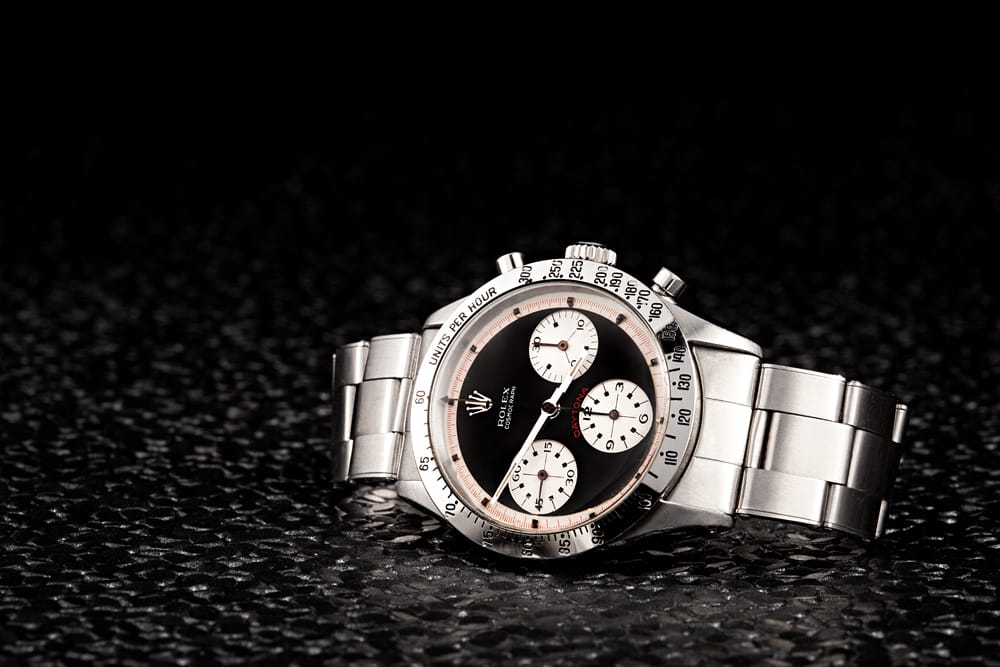
The Rolex Daytona Story
The engine revving and high speed driving is thrilling. But capturing time when speed is your objective can be difficult. The Oyster Perpetual Cosmograph Daytona is the perfect accessory for those seeking high performance, fine engineering and craftsmanship, and, of course, a passion for driving and speed. The Daytona is the best example of the Rolex chronography. It is reliable, waterproof, and self-winding, among its many features.
The Rolex Daytona and Paul Newman
The Rolex Daytona is named for the city where the first NASCAR race was held. Daytona has always been associated with racing, and the Rolex Daytona lives up to that reputation with its chronograph functions. Originally designed for racecar drivers, the Rolex Daytona shot to fame when Paul Newman sported his own model. Preceded by the Reference 6238, the Daytona evolved from a simple timekeeping watch to a "chronograph" watch that marked all types of information useful to those timing races.
The Rolex Daytona history begins in 1963 after the brands release of their Cosmograph Daytona collection. It was a new-generation chronograph, considered in many respects to be the ultimate chronograph. Dedicated to racing drivers, the Daytona provides the high performance accepted, while also remaining comfortable and elegant. It offers several features particular to drivers. The chronograph counters are easily seen, as they stand out clearly with strongly contrasting black and light color of the face and dials. The tachymetric scale, allowing the user to measure the average speed over a given distance, was moved from the dial to the circumference of the bezel. This new design feature, along with the contrasting coloring made the symbols far more legible.
Daytona Features
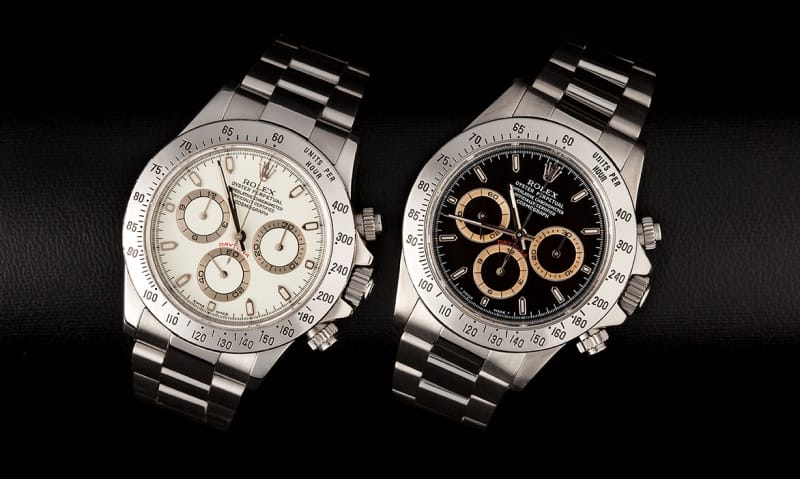
In 2013, the Daytona became the first Oyster model in the Professional range to be offered in platinum, which we wrote about in our Rolex Daytona Platinum guide. It also features a unique ice blue dial, exclusive to its Rolex platinum models. It is also equipped with a spectacular monobloc Cerachrom bezel. The Cerachrom is an exclusive Rolex innovation which offers exceptional resistance against scratching, as well as offering a beautiful and aesthetic appearance. The technical and sporty look of the Dayton make it instantly recognizable and timeless.
Rolex Professional watches are members of a ten year old category dedicated to various adventurers. For example, models such as the explorer were dedicated to explorers and mountaineers, offering special features that those in that particular experience could utilize. Like the explorer and Daytona watches, the Oyster Perpetual Submariner is a member of the Professional category, specially designed for those who pursue deep-sea diving. As such, some collectors refer to this model as a dive watch.
Pros and Cons of the Submariner and Daytona
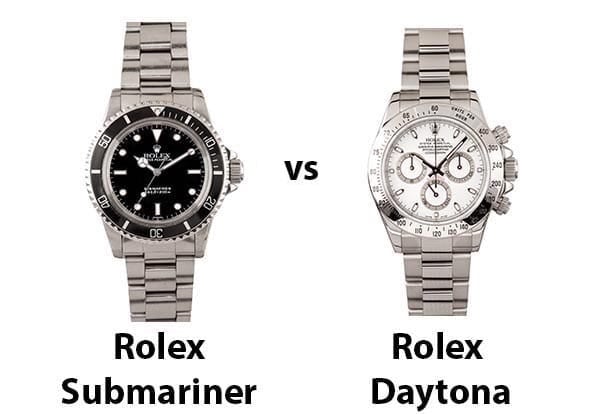
When it comes to pros and cons of each watch, the pros obviously win for both models! Rolex watches are always a good investment no matter which model you choose. However, each of these models has particular characteristics that make them a great choice.
Benefits of the Rolex Submariner |
|
Submariner's Drawbacks |
|
Benefits of the Rolex Daytona |
|
Daytona's Drawbacks |
|
Design & Aesthetics
When examining the world of Rolex, the Submariner and Daytona emerge as distinct jewels, each shimmering with its unique charm, design ethos, and historical significance. The Submariner, conceived and crafted primarily as a beacon for divers, portrays a potent blend of ruggedness and elegance. Its design, reminiscent of the mysteries of the deep ocean, is undeniably captivating. The bold luminescent hour markers, the harmonious symmetry of its face, and the robust case give it a commanding presence.
Contrastingly, the Daytona, a legend born from the world of motorsport, resonates with dynamism and swift elegance. Taking inspiration from the racetracks, its design is a testament to speed, precision, and the thrill of the chase. The intricate sub-dials, representative of a car's dashboard, combined with the sleek bezel marked for tachymetric readings, exude a sporty sophistication. Its pushers, reminiscent of gear shifts, further emphasize its racing pedigree.
Yet, despite their differing backgrounds, there's an underlying Rolex DNA that binds them - an undeniable commitment to unparalleled craftsmanship and timeless design. In the grand debate of Rolex Submariner vs Daytona from a design perspective, each watch holds its ground firmly, appealing to distinct yet equally passionate audiences.
Materials and Colors
Rolex, a brand synonymous with luxury and meticulous craftsmanship, goes to great lengths when selecting materials for its watches, ensuring that the Submariner and Daytona not only look stunning but also stand the test of time.
For the Submariner, robustness is essential, given its marine lineage. It is often fashioned from a blend of Oystersteel – a superalloy known for its resistance to corrosion and unparalleled shine. For those with an affinity for opulence, Rolex offers variations in yellow, white, and Everose gold, with some models even showcasing a harmonious meld of gold and steel, aptly termed "Rolesor."
The Daytona, though rooted in the fast-paced world of racing, doesn't skimp on luxury. Oystersteel versions are popular, exuding a sleek, modern look. But those with discerning tastes might gravitate towards its gold renditions or the lavish platinum model, which boasts a lustrous sheen unlike any other.
When it comes to colors, the Submariner's palette leans towards the classics - think deep blacks, oceanic blues, and the famed green of the "Hulk" model. The Daytona, meanwhile, offers a broader spectrum, with dial colors ranging from the icy coolness of white to the sophisticated allure of black, and even the celestial charm of a meteorite dial.
In the battle of "Rolex Submariner vs Daytona," materials and colors play a pivotal role, with each watch making a statement that resonates with its storied heritage.
Dial & Display
Within the illustrious world of Rolex, the dial is not just a mere component; it's a canvas where art meets functionality. When comparing the Rolex Submariner and Daytona, their dials serve as the most expressive facets of their identities.
The Submariner’s dial is a masterclass in clarity and purpose-driven design. Born from the ocean's depths, its primary goal is legibility under all conditions. This intent manifests in large, luminescent hour markers and hands that ensure a clear read even in the murkiest waters or dimmest light. Subtleties like the date window, protected by a Cyclops lens on some variants, further refine its functionality while adding an unmistakable Rolex signature.
The Daytona, on the other hand, offers a dial bustling with complexities mirroring the world of motorsports. Its triad of subdials - tracking seconds, elapsed minutes, and hours - pay homage to its chronographic lineage. While maintaining an air of elegance, these subdials serve racers and enthusiasts in measuring speed and elapsed time. Additionally, the contrasting colors and well-defined markers enhance readability, ensuring it's not just an accessory but a tool for champions.
In the "Rolex Submariner vs Daytona" discourse, the dials serve as a window into the ethos and evolution of these horological legends, capturing both their spirit and function.
Movement & Mechanics
The heart of any timepiece is its movement, a symphony of precision, engineering, and art. For Rolex, this is a domain where no compromise is tolerated, ensuring that both the Submariner and Daytona excel not just in form, but in function.
The Submariner, a beacon for divers worldwide, houses the impressive Calibre 3235. This self-winding mechanical movement is a testament to Rolex's innovative spirit. With an approximately 70-hour power reserve, it ensures that timekeeping remains consistent even when the watch isn't worn for extended periods. It's not just about longevity; the 3235 also boasts a Parachrom hairspring, providing greater resistance to shocks and temperature variations, vital for the unpredictable underwater environment.
In contrast, the Daytona's heart beats with the Calibre 4130, a chronograph movement that encapsulates its racing soul. Beyond its precise timekeeping, this movement accommodates the watch's complex stopwatch functions, crucial for measuring lap times on the racetrack. Moreover, its simplified design enhances its reliability and eases maintenance, making it a favorite among horologists and watch aficionados alike.
When dissecting the Rolex Submariner vs Daytona debate, the movements within these masterpieces stand as monumental testaments to Rolex's commitment to pioneering advancements, ensuring that each tick not only measures time but also encapsulates decades of horological expertise.
Water Resistance & Durability
At the very core of Rolex's legacy lies an unwavering commitment to resilience and precision under pressure. This dedication comes vibrantly alive when examining the water resistance and durability of the Submariner and Daytona, two icons each forged with a distinct purpose in mind.
The Submariner, with its nautical roots, was birthed as a true companion for the deep-sea diver. With an impressive water resistance that reaches depths of up to 300 meters (1,000 feet), it's equipped to endure the crushing pressures of the ocean deep. This resistance isn't merely a numerical value; it's a lifeline for divers, a testament to Rolex's dedication to safety and reliability. Beyond just water resistance, the Submariner's Oyster case, crafted from a solid block of corrosion-resistant Oystersteel, offers robust protection against the harshest elements, be it saltwater, sand, or external shocks.
On the flip side, while the Daytona might not venture as deep as its marine counterpart, its resilience is not to be underestimated. Tailored for the racetrack, it boasts a commendable water resistance suitable for sudden rain showers during a race or unexpected splashes. Its construction, too, reflects robustness, ensuring longevity even in the demanding environment of high-speed racing.
When contemplating the "Rolex Submariner vs Daytona" narrative, it's clear that both timepieces are not just statements of luxury but robust companions, ready to withstand life's challenges.
Bracelet & Comfort
The bracelet of a timepiece, while often overlooked, plays a pivotal role in defining the wearer's experience. It's a testament to Rolex's dedication to user comfort and design excellence that both the Submariner and Daytona offer bracelets that are as much about luxury as they are about ergonomic brilliance.
The Submariner is typically adorned with the renowned Oyster bracelet, known for its broad, flat three-piece link design. This bracelet, constructed with precision and care, ensures that the watch sits comfortably on the wrist, making prolonged wear a pleasure rather than a strain. Its Glidelock clasp is a masterstroke of engineering, allowing wearers to make fine adjustments without any tools - a boon, especially for divers adjusting over a wetsuit.
Conversely, the Daytona, while often sporting the Oyster bracelet, has also been known to feature the elegant Oysterflex bracelet. This high-performance elastomer strap retains the robustness and reliability of metal while providing the suppleness and comfort of rubber. The integration of a cushion system on the inside of the Oysterflex also ensures optimal comfort, a nod to Rolex's commitment to luxury in every detail.
In the debate of "Rolex Submariner vs Daytona", the focus often veers towards their iconic designs and functionalities. Yet, it's their bracelets, those silent bearers of craftsmanship and comfort, that truly amplify the wearing experience, binding the wearer in a bond of luxury and ease.
Special Editions & Collaborations
Rolex's journey has been punctuated with timepieces that not only tell time but also tell stories. The Submariner and Daytona, two stalwarts of the Rolex lineup, have seen a myriad of special editions and collaborations that have elevated their legendary status further.
The Submariner's rich maritime legacy has birthed editions like the green "Hulk" and the blue "Smurf," each variant bringing a fresh, distinct hue to the classic Submariner silhouette, further enriching its oceanic narrative.
The Daytona, with its roots firmly embedded in motorsports, has witnessed collaborations that resonate with speed and endurance. Notably, the partnership with racing legend Paul Newman gave rise to the "Paul Newman" Daytona, a timepiece that's become a coveted collector's item, epitomizing the spirit of racing and the allure of celebrity.
As we journey through the Rolex Submariner vs Daytona chronicles, these special editions and collaborations serve as milestones, celebrating the dynamic intersections of horological craftsmanship, history, and pop culture.
Price & Resale Value
In the world of horology, few brands command as much respect and value as Rolex. When it comes to the Submariner and Daytona, both watches are not just luxurious accessories but also investments. Their intrinsic value isn't solely tied to their initial price but also their potential for appreciation over time.
The Submariner, with its timeless design and marine heritage, has consistently been a favorite among collectors and enthusiasts. Its steady demand and iconic status often translate to impressive resale figures, with certain vintage models fetching particularly high returns.
The Daytona, enriched by its racing legacy and memorable collaborations, stands as a beacon of collectability. Special editions, especially those with significant historical or celebrity associations, have seen exceptional value retention and appreciation.
When considering "Rolex Submariner vs Daytona" from a financial perspective, both watches showcase Rolex's unparalleled ability to meld luxury, history, and investment potential into masterpieces that stand the test of time.
Pricing for Submariner and Daytona
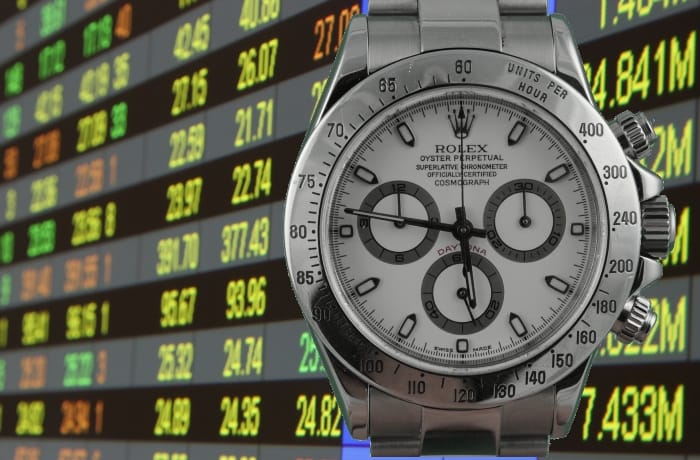
The price of each watch is, of course, dependent on age, condition and other factors but in general the Submariner costs less than a Daytona of similar age and condition. The Submariner starts at around $5,000 used and can escalate to as much as $15,000, while the Daytona will probably not be found for less than $6,500 and may go up to as much as $25,000.
Choosing Your Watch
Depending on the adventure one wishes to pursue, Rolex offers many high performance options. For those wishing to measure speed, particularly when driving, the Daytona is an excellent choice. Utilizing its conveniently placed tachymetric scale, for example, one can measure their average speed over a given distance. For those seeking adventure in the murky depths of the ocean, the Submariner would be an excellent choice. Resisting water pressure up to 3900 meters (12,800 feet), depending on the model, the Submariner offers many features specific to divers, including a monobloc Cerachrom bezel, marked to ensure divers adequately and accurately monitor their dive time. One who wishes to dive should consider the Submariner over the Daytona. Though both are waterproof, the Submariner offers many other advanced features that only a diver would be able to truly utilize. Thus, it is important to determine what the use will be, then determine which watch offers the most features to meet that. Both are superb pieces of craftsmanship, with neither being better than the other. Rather, their value is found in how you wish to use them.
In general, the Submariner is a considered a good sports watch. It also make a great first-time Rolex watch purchase. The Daytona is a considered a dress watch and is more appropriate in formal settings.